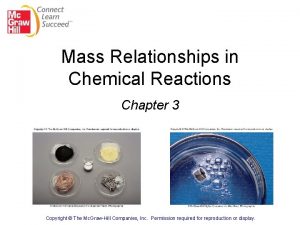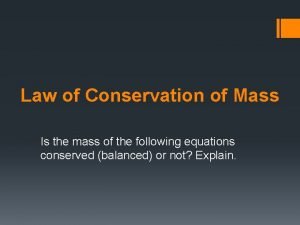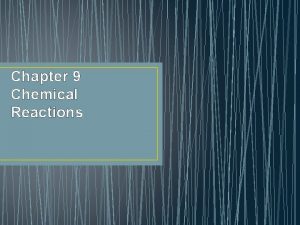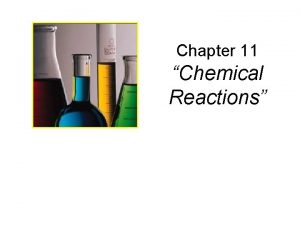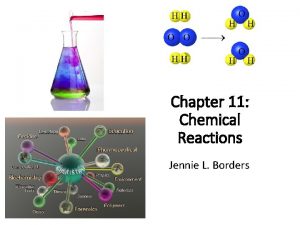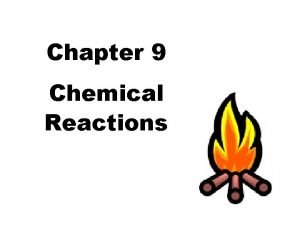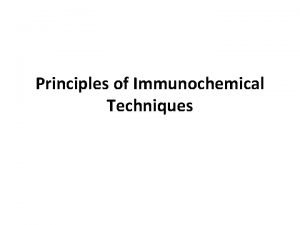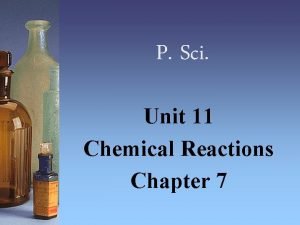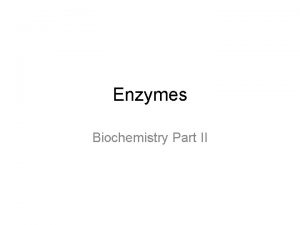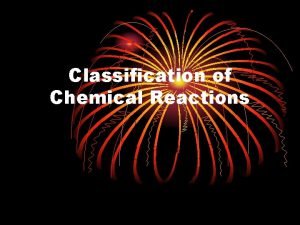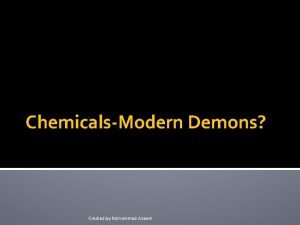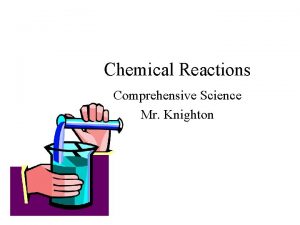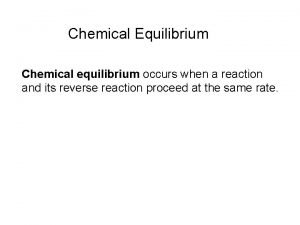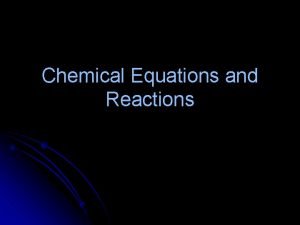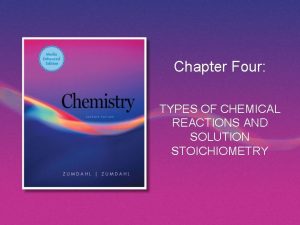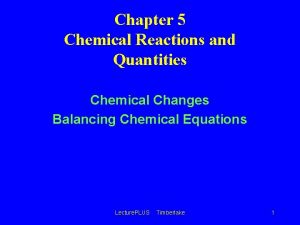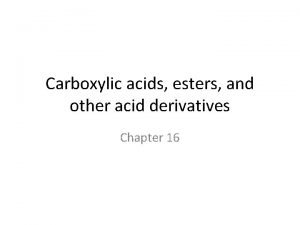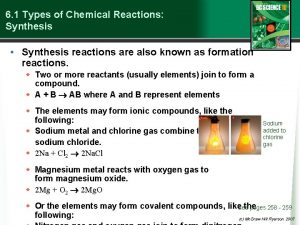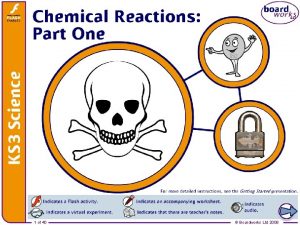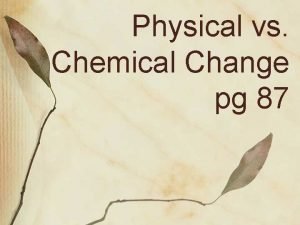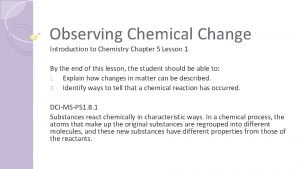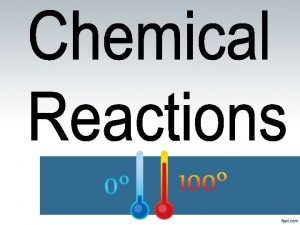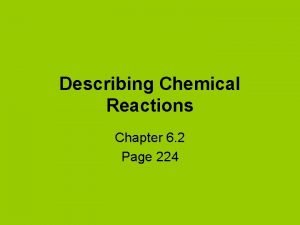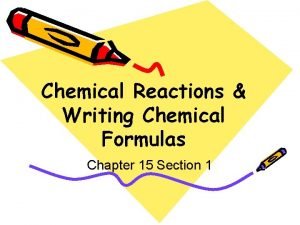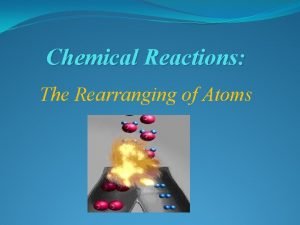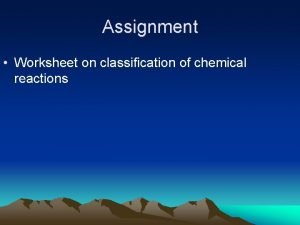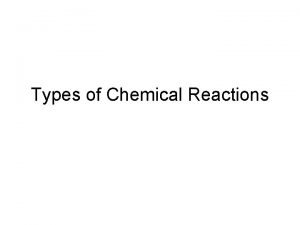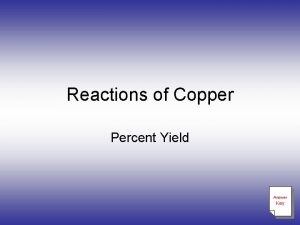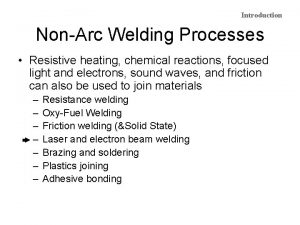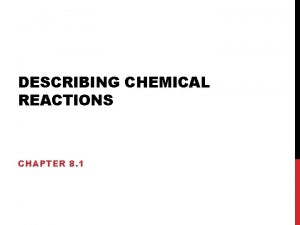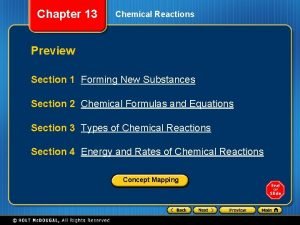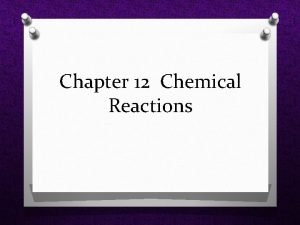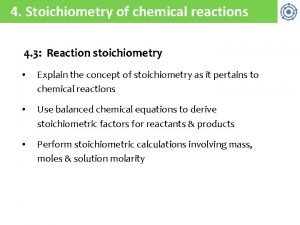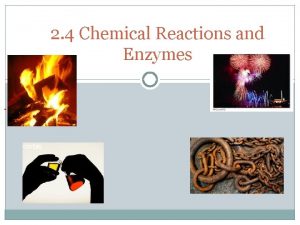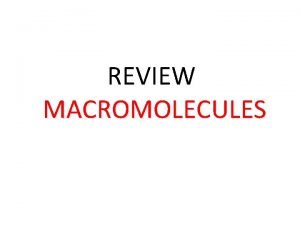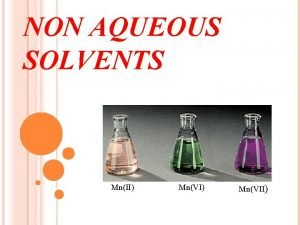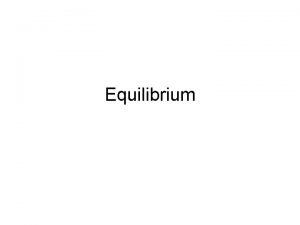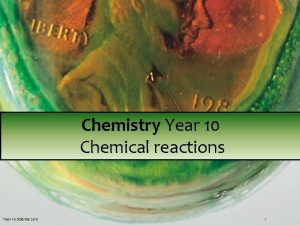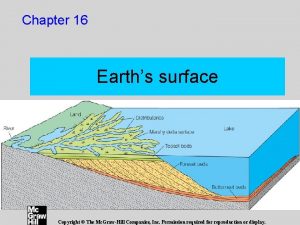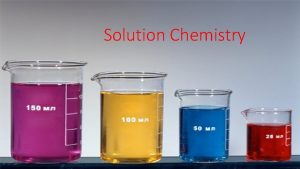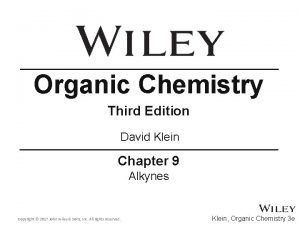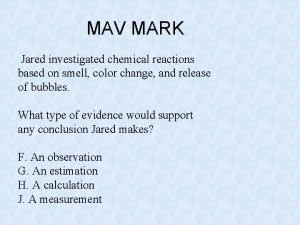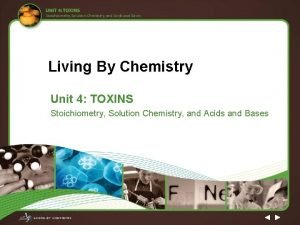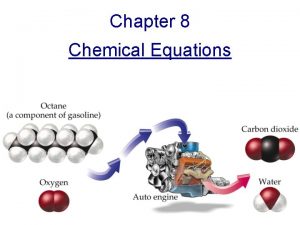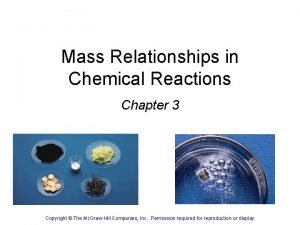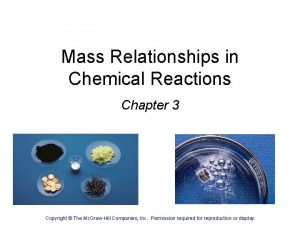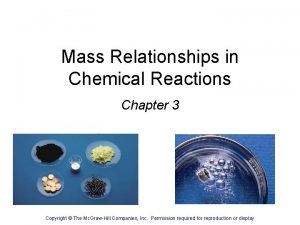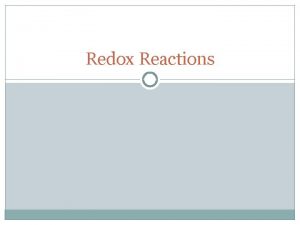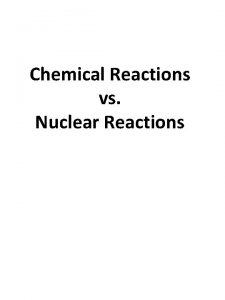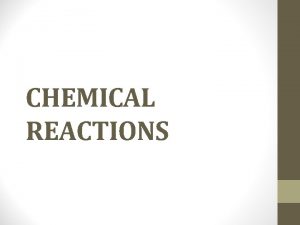Mass Relationships in Chemical Reactions Chapter 3 Copyright








































































![Example 3. 15 Urea [(NH 2)2 CO] is prepared by reacting ammonia with carbon Example 3. 15 Urea [(NH 2)2 CO] is prepared by reacting ammonia with carbon](https://slidetodoc.com/presentation_image_h/8dec5f8a005af5ca26a4ab4d9bd01dc7/image-73.jpg)















- Slides: 88

Mass Relationships in Chemical Reactions Chapter 3 Copyright © The Mc. Graw-Hill Companies, Inc. Permission required for reproduction or display.

Chapter 3 Mass Relationships in Chemical Reactions 3. 1 3. 2 3. 3 3. 4 3. 5 3. 6 3. 7 3. 8 3. 9 3. 10 Atomic Mass Avogadro’s Number and Molar Mass of an Element Molecular Mass The Mass Spectrometer Percent Composition of Compounds Experimental Determination of Empirical Formulas Chemical Reactions and Chemical Equations Amounts of Reactants and Products Limiting Reagent Calculations Reaction Yield 2

Micro World atoms & molecules Macro World grams Atomic mass is the mass of an atom in atomic mass units (amu) By definition: 1 atom 12 C “weighs” 12 amu On this scale 1 H = 1. 008 amu 16 O = 16. 00 amu 3

The average atomic mass is the weighted average of all of the naturally occurring isotopes of the element. 4

Micro World atoms & molecules Macro World grams Atomic mass is the mass of an atom in atomic mass units (amu) By definition: 1 atom 12 C “weighs” 12 amu On this scale 1 H = 1. 008 amu 16 O = 16. 00 amu 5

Average atomic mass (63. 55) 6

The Mole (mol): A unit to count numbers of particles Dozen = 12 Pair = 2 The mole (mol) is the amount of a substance that contains as many elementary entities as there atoms in exactly 12. 00 grams of 12 C 1 mol = NA = 6. 0221415 x 1023 Avogadro’s number (NA) 7

eggs shoes Molar mass is the mass of 1 mole of in grams marbles atoms 1 mole 12 C atoms = 6. 022 x 1023 atoms = 12. 00 g 1 12 C atom = 12. 00 amu 1 mole 12 C atoms = 12. 00 g 12 C 1 mole lithium atoms = 6. 941 g of Li For any element atomic mass (amu) = molar mass (grams) 8

One Mole of: S C Hg Cu Fe 9

1 12 C atom 12. 00 g 1. 66 x 10 -24 g x = 23 12 12. 00 amu 6. 022 x 10 C atoms 1 amu = 1. 66 x 10 -24 g or 1 g = 6. 022 x 1023 amu M = molar mass in g/mol NA = Avogadro’s number 10

Example 3. 2 Helium (He) is a valuable gas used in industry, lowtemperature research, deep -sea diving tanks, and balloons. How many moles of He atoms are in 6. 46 g of He? A scientific research helium balloon.

Example 3. 2 Solution The conversion factor needed to convert between grams and moles is the molar mass. In the periodic table (see inside front cover) we see that the molar mass of He is 4. 003 g. This can be expressed as 1 mol He = 4. 003 g He From this equality, we can write two conversion factors

Example 3. 2 Grams will cancel, leaving the unit mol for the answer, that is, Thus, there are 1. 61 moles of He atoms in 6. 46 g of He. Check Because the given mass (6. 46 g) is larger than the molar mass of He, we expect to have more than 1 mole of He.

Example 3. 3 Zinc (Zn) is a silvery metal that is used in making brass (with copper) and in plating iron to prevent corrosion. How many grams of Zn are in 0. 356 mole of Zn? Zinc

Example 3. 3 Solution The conversion factor needed to convert between moles and grams is the molar mass. In the periodic table (see inside front cover) we see the molar mass of Zn is 65. 39 g. This can be expressed as 1 mol Zn = 65. 39 g Zn From this equality, we can write two conversion factors The conversion factor on the right is the correct one.

Example 3. 3 Moles will cancel, leaving unit of grams for the answer. The number of grams of Zn is Thus, there are 23. 3 g of Zn in 0. 356 mole of Zn. Check Does a mass of 23. 3 g for 0. 356 mole of Zn seem reasonable? What is the mass of 1 mole of Zn?

Example 3. 4 Sulfur (S) is a nonmetallic element that is present in coal. When coal is burned, sulfur is converted to sulfur dioxide and eventually to sulfuric acid that gives rise to the acid rain phenomenon. How many atoms are in 16. 3 g of S? Elemental sulfur (S 8) consists of eight S atoms joined in a ring.

Example 3. 4 Solution We need two conversions: first from grams to moles and then from moles to number of particles (atoms). The first step is similar to Example 3. 2. Because 1 mol S = 32. 07 g S the conversion factor is Avogadro’s number is the key to the second step. We have 1 mol = 6. 022 × 1023 particles (atoms)

Example 3. 4 and the conversion factors are The conversion factor on the left is the one we need because it has number of S atoms in the numerator. We can solve the problem by first calculating the number of moles contained in 16. 3 g of S, and then calculating the number of S atoms from the number of moles of S:

Example 3. 4 We can combine these conversions in one step as follows: Thus, there are 3. 06 × 1023 atoms of S in 16. 3 g of S. Check Should 16. 3 g of S contain fewer than Avogadro’s number of atoms? What mass of S would contain Avogadro’s number of atoms?

Molecular mass (or molecular weight) is the sum of the atomic masses (in amu) in a molecule. 1 S 2 O SO 2 32. 07 amu + 2 x 16. 00 amu 64. 07 amu SO 2 For any molecule molecular mass (amu) = molar mass (grams) 1 molecule SO 2 = 64. 07 amu 1 mole SO 2 = 64. 07 g SO 2 21

Example 3. 5 Calculate the molecular masses (in amu) of the following compounds: a)sulfur dioxide (SO 2), a gas that is responsible for acid rain b)caffeine (C 8 H 10 N 4 O 2), a stimulant present in tea, coffee, and cola beverages

Example 3. 5 Strategy How do atomic masses of different elements combine to give the molecular mass of a compound? Solution To calculate molecular mass, we need to sum all the atomic masses in the molecule. For each element, we multiply the atomic mass of the element by the number of atoms of that element in the molecule. We find atomic masses in the periodic table (inside front cover). • There are two O atoms and one S atom in SO 2, so that molecular mass of SO 2 = 32. 07 amu + 2(16. 00 amu) = 64. 07 amu

Example 3. 5 (b) There are eight C atoms, ten H atoms, four N atoms, and two O atoms in caffeine, so the molecular mass of C 8 H 10 N 4 O 2 is given by 8(12. 01 amu) + 10(1. 008 amu) + 4(14. 01 amu) + 2(16. 00 amu) = 194. 20 amu

Example 3. 6 Methane (CH 4) is the principal component of natural gas. How many moles of CH 4 are present in 6. 07 g of CH 4?

Example 3. 6 Solution The conversion factor needed to convert between grams and moles is the molar mass. First we need to calculate the molar mass of CH 4, following the procedure in Example 3. 5: molar mass of CH 4 = 12. 01 g + 4(1. 008 g) = 16. 04 g Because 1 mol CH 4 = 16. 04 g CH 4 the conversion factor we need should have grams in the denominator so that the unit g will cancel, leaving the unit mol in the numerator:

Example 3. 6 We now write Thus, there is 0. 378 mole of CH 4 in 6. 07 g of CH 4. Check Should 6. 07 g of CH 4 equal less than 1 mole of CH 4? What is the mass of 1 mole of CH 4?

Example 3. 7 How many hydrogen atoms are present in 25. 6 g of urea [(NH 2)2 CO], which is used as a fertilizer, in animal feed, and in the manufacture of polymers? The molar mass of urea is 60. 06 g. urea

Example 3. 7 Solution To calculate the number of H atoms, we first must convert grams of urea to moles of urea using the molar mass of urea. This part is similar to Example 3. 2. The molecular formula of urea shows there are four moles of H atoms in one mole of urea molecule, so the mole ratio is 4: 1. Finally, knowing the number of moles of H atoms, we can calculate the number of H atoms using Avogadro’s number. We need two conversion factors: molar mass and Avogadro’s number.

Example 3. 7 We can combine these conversions into one step: = 1. 03 × 1024 H atoms Check Does the answer look reasonable? How many atoms of H would 60. 06 g of urea contain?

Formula mass is the sum of the atomic masses (in amu) in a formula unit of an ionic compound. 1 Na Na. Cl 22. 99 amu 1 Cl + 35. 45 amu Na. Cl 58. 44 amu For any ionic compound formula mass (amu) = molar mass (grams) 1 formula unit Na. Cl = 58. 44 amu 1 mole Na. Cl = 58. 44 g Na. Cl 31

Heavy Light Mass Spectrometer Mass Spectrum of Ne 32

Percent composition of an element in a compound = n x molar mass of element x 100% molar mass of compound n is the number of moles of the element in 1 mole of the compound 2 x (12. 01 g) x 100% = 52. 14% 46. 07 g 6 x (1. 008 g) %H = x 100% = 13. 13% 46. 07 g 1 x (16. 00 g) %O = x 100% = 34. 73% 46. 07 g %C = C 2 H 6 O 52. 14% + 13. 13% + 34. 73% = 100. 0% 33

Example 3. 8 Phosphoric acid (H 3 PO 4) is a colorless, syrupy liquid used in detergents, fertilizers, toothpastes, and in carbonated beverages for a “tangy” flavor. Calculate the percent composition by mass of H, P, and O in this compound.

Example 3. 8 Strategy Recall the procedure for calculating a percentage. Assume that we have 1 mole of H 3 PO 4. The percent by mass of each element (H, P, and O) is given by the combined molar mass of the atoms of the element in 1 mole of H 3 PO 4 divided by the molar mass of H 3 PO 4, then multiplied by 100 percent.

Example 3. 8 Solution The molar mass of H 3 PO 4 is 97. 99 g. The percent by mass of each of the elements in H 3 PO 4 is calculated as follows: Check Do the percentages add to 100 percent? The sum of the percentages is (3. 086% + 31. 61% + 65. 31%) = 100. 01%. The small discrepancy from 100 percent is due to the way we rounded off.

Example To Do at Home Percent Composition • Example: Which element has highest percentage of carbon? CH 4, C 2 H 2 O 3, C 10 H 22 O 11

Percent Composition and Empirical Formulas 38

Example 3. 9 Ascorbic acid (vitamin C) cures scurvy. It is composed of 40. 92 percent carbon (C), 4. 58 percent hydrogen (H), and 54. 50 percent oxygen (O) by mass. Determine its empirical formula.

Example 3. 9 Strategy In a chemical formula, the subscripts represent the ratio of the number of moles of each element that combine to form one mole of the compound. How can we convert from mass percent to moles? If we assume an exactly 100 -g sample of the compound, do we know the mass of each element in the compound? How do we then convert from grams to moles?

Example 3. 9 Solution If we have 100 g of ascorbic acid, then each percentage can be converted directly to grams. In this sample, there will be 40. 92 g of C, 4. 58 g of H, and 54. 50 g of O. Because the subscripts in the formula represent a mole ratio, we need to convert the grams of each element to moles. The conversion factor needed is the molar mass of each element. Let n represent the number of moles of each element so that

Example 3. 9 Thus, we arrive at the formula C 3. 407 H 4. 54 O 3. 406, which gives the identity and the mole ratios of atoms present. However, chemical formulas are written with whole numbers. Try to convert to whole numbers by dividing all the subscripts by the smallest subscript (3. 406): where the sign means “approximately equal to. ” This gives CH 1. 33 O as the formula for ascorbic acid. Next, we need to convert 1. 33, the subscript for H, into an integer.

Example 3. 9 This can be done by a trial-and-error procedure: 1. 33 × 1 = 1. 33 × 2 = 2. 66 1. 33 × 3 = 3. 99 < 4 Because 1. 33 × 3 gives us an integer (4), we multiply all the subscripts by 3 and obtain C 3 H 4 O 3 as the empirical formula for ascorbic acid. Check Are the subscripts in C 3 H 4 O 3 reduced to the smallest whole numbers?

Example 3. 10 Chalcopyrite (Cu. Fe. S 2) is a principal mineral of copper. Calculate the number of kilograms of Cu in 3. 71 × 103 kg of chalcopyrite. Chalcopyrite.

Example 3. 10 Strategy Chalcopyrite is composed of Cu, Fe, and S. The mass due to Cu is based on its percentage by mass in the compound. How do we calculate mass percent of an element? Solution The molar masses of Cu and Cu. Fe. S 2 are 63. 55 g and 183. 5 g, respectively. The mass percent of Cu is therefore

Example 3. 10 To calculate the mass of Cu in a 3. 71 × 103 kg sample of Cu. Fe. S 2, we need to convert the percentage to a fraction (that is, convert 34. 63 percent to 34. 63/100, or 0. 3463) and write mass of Cu in Cu. Fe. S 2 = 0. 3463 × (3. 71 × 103 kg) = 1. 28 × 103 kg Check As a ball-park estimate, note that the mass percent of Cu is roughly 30 % percent, so that a third of the mass should be Cu; that is, (1/3) × 3. 71 × 103 kg 1. 24 × 103 kg. This quantity is quite close to the answer.

Combust 11. 5 g ethanol Collect 22. 0 g CO 2 and 13. 5 g H 2 O g CO 2 mol C g C 6. 0 g C = 0. 5 mol C g H 2 O mol H g H 1. 5 g H = 1. 5 mol H g of O = g of sample – (g of C + g of H) 4. 0 g O = 0. 25 mol O Empirical formula C 0. 5 H 1. 5 O 0. 25 Divide by smallest subscript (0. 25) Empirical formula C 2 H 6 O 47

Example 3. 11 A sample of a compound contains 30. 46 percent nitrogen and 69. 54 percent oxygen by mass, as determined by a mass spectrometer. In a separate experiment, the molar mass of the compound is found to be between 90 g and 95 g. Determine the molecular formula and the accurate molar mass of the compound.

Example 3. 11 Strategy To determine the molecular formula, we first need to determine the empirical formula. Comparing the empirical molar mass to the experimentally determined molar mass will reveal the relationship between the empirical formula and molecular formula. Solution We start by assuming that there are 100 g of the compound. Then each percentage can be converted directly to grams; that is, 30. 46 g of N and 69. 54 g of O.

Example 3. 11 Let n represent the number of moles of each element so that Thus, we arrive at the formula N 2. 174 O 4. 346, which gives the identity and the ratios of atoms present. However, chemical formulas are written with whole numbers. Try to convert to whole numbers by dividing the subscripts by the smaller subscript (2. 174). After rounding off, we obtain NO 2 as the empirical formula.

Example 3. 11 The molecular formula might be the same as the empirical formula or some integral multiple of it (for example, two, three, four, or more times the empirical formula). Comparing the ratio of the molar mass to the molar mass of the empirical formula will show the integral relationship between the empirical and molecular formulas. The molar mass of the empirical formula NO 2 is empirical molar mass = 14. 01 g + 2(16. 00 g) = 46. 01 g

Example 3. 11 Next, we determine the ratio between the molar mass and the empirical molar mass The molar mass is twice the empirical molar mass. This means that there are two NO 2 units in each molecule of the compound, and the molecular formula is (NO 2)2 or N 2 O 4. The actual molar mass of the compound is two times the empirical molar mass, that is, 2(46. 01 g) or 92. 02 g, which is between 90 g and 95 g.

Example 3. 11 Check Note that in determining the molecular formula from the empirical formula, we need only know the approximate molar mass of the compound. The reason is that the true molar mass is an integral multiple (1×, 2×, 3×, . . . ) of the empirical molar mass. Therefore, the ratio (molar mass/empirical molar mass) will always be close to an integer.

A process in which one or more substances is changed into one or more new substances is a chemical reaction. A chemical equation uses chemical symbols to show what happens during a chemical reaction: reactants products 3 ways of representing the reaction of H 2 with O 2 to form H 2 O 54

How to “Read” Chemical Equations 2 Mg + O 2 2 Mg. O 2 atoms Mg + 1 molecule O 2 makes 2 formula units Mg. O 2 moles Mg + 1 mole O 2 makes 2 moles Mg. O 48. 6 grams Mg + 32. 0 grams O 2 makes 80. 6 g Mg. O NOT 2 grams Mg + 1 gram O 2 makes 2 g Mg. O 55

Balancing Chemical Equations 1. Write the correct formula(s) for the reactants on the left side and the correct formula(s) for the product(s) on the right side of the equation. Ethane reacts with oxygen to form carbon dioxide and water C 2 H 6 + O 2 CO 2 + H 2 O 2. Change the numbers in front of the formulas (coefficients) to make the number of atoms of each element the same on both sides of the equation. Do not change the subscripts. 2 C 2 H 6 NOT C 4 H 12 56

Balancing Chemical Equations 3. Start by balancing those elements that appear in only one reactant and one product. C 2 H 6 + O 2 2 carbon on left C 2 H 6 + O 2 6 hydrogen on left C 2 H 6 + O 2 CO 2 + H 2 O start with C or H but not O 1 carbon on right multiply CO 2 by 2 2 CO 2 + H 2 O 2 hydrogen on right 2 CO 2 + 3 H 2 O multiply H 2 O by 3 57

Balancing Chemical Equations 4. Balance those elements that appear in two or more reactants or products. C 2 H 6 + O 2 2 oxygen on left 2 CO 2 + 3 H 2 O multiply O 2 by 7 2 4 oxygen + 3 oxygen = 7 oxygen (3 x 1) on right (2 x 2) 7 C 2 H 6 + O 2 2 2 CO 2 + 3 H 2 O 2 C 2 H 6 + 7 O 2 4 CO 2 + 6 H 2 O remove fraction multiply both sides by 2 58

Balancing Chemical Equations 5. Check to make sure that you have the same number of each type of atom on both sides of the equation. 2 C 2 H 6 + 7 O 2 4 CO 2 + 6 H 2 O 4 C (2 x 2) 4 C 12 H (2 x 6) 12 H (6 x 2) 14 O (7 x 2) 14 O (4 x 2 + 6) Reactants 4 C 12 H 14 O Products 4 C 12 H 14 O 59

Example 3. 12 When aluminum metal is exposed to air, a protective layer of aluminum oxide (Al 2 O 3) forms on its surface. This layer prevents further reaction between aluminum and oxygen, and it is the reason that aluminum beverage cans do not corrode. [In the case of iron, the rust, or iron(III) oxide, that forms is too porous to protect the iron metal underneath, so rusting continues. ] Write a balanced equation for the formation of Al 2 O 3. An atomic scale image of aluminum oxide.

Example 3. 12 Strategy Remember that the formula of an element or compound cannot be changed when balancing a chemical equation. The equation is balanced by placing the appropriate coefficients in front of the formulas. Follow the procedure described on p. 92. Solution The unbalanced equation is In a balanced equation, the number and types of atoms on each side of the equation must be the same. We see that there is one Al atom on the reactants side and there are two Al atoms on the product side.

Example 3. 12 We can balance the Al atoms by placing a coefficient of 2 in front of Al on the reactants side. There are two O atoms on the reactants side, and three O atoms on the product side of the equation. We can balance the O atoms by placing a coefficient of in front of O 2 on the reactants side. This is a balanced equation. However, equations are normally balanced with the smallest set of whole-number coefficients.

Example 3. 12 Multiplying both sides of the equation by 2 gives whole-number coefficients. or Check For an equation to be balanced, the number and types of atoms on each side of the equation must be the same. The final tally is The equation is balanced. Also, the coefficients are reduced to the simplest set of whole numbers.

Amounts of Reactants and Products 1. Write balanced chemical equation 2. Convert quantities of known substances into moles 3. Use coefficients in balanced equation to calculate the number of moles of the sought quantity 4. Convert moles of sought quantity into desired units 64

Example 3. 13 The food we eat is degraded, or broken down, in our bodies to provide energy for growth and function. A general overall equation for this very complex process represents the degradation of glucose (C 6 H 12 O 6) to carbon dioxide (CO 2) and water (H 2 O): If 856 g of C 6 H 12 O 6 is consumed by a person over a certain period, what is the mass of CO 2 produced?

Example 3. 13 Solution We follow the preceding steps and Figure 3. 8. Step 1: The balanced equation is given in the problem. Step 2: To convert grams of C 6 H 12 O 6 to moles of C 6 H 12 O 6, we write Step 3: From the mole ratio, we see that 1 mol C 6 H 12 O 6 6 mol CO 2. Therefore, the number of moles of CO 2 formed is

Example 3. 13 Step 4: Finally, the number of grams of CO 2 formed is given by After some practice, we can combine the conversion steps into one equation:

Example 3. 13 Check Does the answer seem reasonable? Should the mass of CO 2 produced be larger than the mass of C 6 H 12 O 6 reacted, even though the molar mass of CO 2 is considerably less than the molar mass of C 6 H 12 O 6? What is the mole ratio between CO 2 and C 6 H 12 O 6?

Example 3. 14 All alkali metals react with water to produce hydrogen gas and the corresponding alkali metal hydroxide. A typical reaction is that between lithium and water: How many grams of Li are needed to produce 9. 89 g of H 2? Lithium reacting with water to produce hydrogen gas.

Example 3. 14 Strategy The question asks for number of grams of reactant (Li) to form a specific amount of product (H 2). Therefore, we need to reverse the steps shown in Figure 3. 8. From the equation we see that 2 mol Li 1 mol H 2.

Example 3. 14 Solution The conversion steps are Combining these steps into one equation, we write Check There are roughly 5 moles of H 2 in 9. 89 g H 2, so we need 10 moles of Li. From the approximate molar mass of Li (7 g), does the answer seem reasonable?

Limiting Reagent: Reactant used up first in the reaction. 2 NO + O 2 2 NO 2 NO is the limiting reagent O 2 is the excess reagent 72
![Example 3 15 Urea NH 22 CO is prepared by reacting ammonia with carbon Example 3. 15 Urea [(NH 2)2 CO] is prepared by reacting ammonia with carbon](https://slidetodoc.com/presentation_image_h/8dec5f8a005af5ca26a4ab4d9bd01dc7/image-73.jpg)
Example 3. 15 Urea [(NH 2)2 CO] is prepared by reacting ammonia with carbon dioxide: In one process, 637. 2 g of NH 3 are treated with 1142 g of CO 2. (a) Which of the two reactants is the limiting reagent? (b) Calculate the mass of (NH 2)2 CO formed. (c) How much excess reagent (in grams) is left at the end of the reaction?

Example 3. 15 a) Strategy The reactant that produces fewer moles of product is the limiting reagent because it limits the amount of product that can be formed. How do we convert from the amount of reactant to amount of product? Perform this calculation for each reactant, then compare the moles of product, (NH 2)2 CO, formed by the given amounts of NH 3 and CO 2 to determine which reactant is the limiting reagent.

Example 3. 15 Solution We carry out two separate calculations. First, starting with 637. 2 g of NH 3, we calculate the number of moles of (NH 2)2 CO that could be produced if all the NH 3 reacted according to the following conversions: Combining these conversions in one step, we write

Example 3. 15 Second, for 1142 g of CO 2, the conversions are The number of moles of (NH 2)2 CO that could be produced if all the CO 2 reacted is It follows, therefore, that NH 3 must be the limiting reagent because it produces a smaller amount of (NH 2)2 CO.

Example 3. 15 (b) Strategy We determined the moles of (NH 2)2 CO produced in part (a), using NH 3 as the limiting reagent. How do we convert from moles to grams? Solution The molar mass of (NH 2)2 CO is 60. 06 g. We use this as a conversion factor to convert from moles of (NH 2)2 CO to grams of (NH 2)2 CO: Check Does your answer seem reasonable? 18. 71 moles of product are formed. What is the mass of 1 mole of (NH 2)2 CO?

Example 3. 15 (c) Strategy Working backward, we can determine the amount of CO 2 that reacted to produce 18. 71 moles of (NH 2)2 CO. The amount of CO 2 left over is the difference between the initial amount and the amount reacted. Solution Starting with 18. 71 moles of (NH 2)2 CO, we can determine the mass of CO 2 that reacted using the mole ratio from the balanced equation and the molar mass of CO 2. The conversion steps are

Example 3. 15 Combining these conversions in one step, we write The amount of CO 2 remaining (in excess) is the difference between the initial amount (1142 g) and the amount reacted (823. 4 g): mass of CO 2 remaining = 1142 g − 823. 4 g = 319 g

Example 3. 16 The reaction between alcohols and halogen compounds to form ethers is important in organic chemistry, as illustrated here for the reaction between methanol (CH 3 OH) and methyl bromide (CH 3 Br) to form dimethylether (CH 3 OCH 3), which is a useful precursor to other organic compounds and an aerosol propellant. This reaction is carried out in a dry (water-free) organic solvent, and the butyl lithium (Li. C 4 H 9) serves to remove a hydrogen ion from CH 3 OH. Butyl lithium will also react with any residual water in the solvent, so the reaction is typically carried out with 2. 5 molar equivalents of that reagent. How many grams of CH 3 Br and Li. C 4 H 9 will be needed to carry out the preceding reaction with 10. 0 g of CH 3 OH?

Example 3. 16 Solution We start with the knowledge that CH 3 OH and CH 3 Br are present in stoichiometric amounts and that Li. C 4 H 9 is the excess reagent. To calculate the quantities of CH 3 Br and Li. C 4 H 9 needed, we proceed as shown in Example 3. 14.

Reaction Yield Theoretical Yield is the amount of product that would result if all the limiting reagent reacted. Actual Yield is the amount of product actually obtained from a reaction. % Yield = Actual Yield Theoretical Yield x 100% 82

Example 3. 17 Titanium is a strong, lightweight, corrosion-resistant metal that is used in rockets, aircraft, jet engines, and bicycle frames. It is prepared by the reaction of titanium(IV) chloride with molten magnesium between 950°C and 1150°C: In a certain industrial operation 3. 54 × 107 g of Ti. Cl 4 are reacted with 1. 13 × 107 g of Mg. • Calculate theoretical yield of Ti in grams. • Calculate the percent yield if 7. 91 × 106 g of Ti are actually obtained.

Example 3. 17 a) Strategy Because there are two reactants, this is likely to be a limiting reagent problem. The reactant that produces fewer moles of product is the limiting reagent. How do we convert from amount of reactant to amount of product? Perform this calculation for each reactant, then compare the moles of product, Ti, formed.

Example 3. 17 Solution Carry out two separate calculations to see which of the two reactants is the limiting reagent. First, starting with 3. 54 × 107 g of Ti. Cl 4, calculate the number of moles of Ti that could be produced if all the Ti. Cl 4 reacted. The conversions are so that

Example 3. 17 Next, we calculate the number of moles of Ti formed from 1. 13 × 107 g of Mg. The conversion steps are And we write Therefore, Ti. Cl 4 is the limiting reagent because it produces a smaller amount of Ti.

Example 3. 17 The mass of Ti formed is (b) Strategy The mass of Ti determined in part (a) is theoretical yield. The amount given in part (b) is the actual yield of the reaction.

Example 3. 17 Solution The percent yield is given by Check Should the percent yield be less than 100 percent?
 Section 2 classifying chemical reactions worksheet answers
Section 2 classifying chemical reactions worksheet answers Section 2 classifying chemical reactions worksheet answers
Section 2 classifying chemical reactions worksheet answers Mass relationships in chemical reactions
Mass relationships in chemical reactions Chapter 18 chemical reactions balancing chemical equations
Chapter 18 chemical reactions balancing chemical equations Chemical reactions section 3 reactions in aqueous solutions
Chemical reactions section 3 reactions in aqueous solutions Proportional relationships in chemical reactions
Proportional relationships in chemical reactions Chemical reactions section 1 chemical changes
Chemical reactions section 1 chemical changes Law of conservation of mass in chemical equations
Law of conservation of mass in chemical equations Chapter 10 chemical reactions answer key
Chapter 10 chemical reactions answer key Chapter 9 chemical reactions study guide
Chapter 9 chemical reactions study guide Chapter 9 chemical reactions
Chapter 9 chemical reactions Chapter 8 review chemical equations and reactions section 2
Chapter 8 review chemical equations and reactions section 2 Chemical reactions chapter 9 study guide
Chemical reactions chapter 9 study guide Chapter 8 section 1 chemical equations and reactions
Chapter 8 section 1 chemical equations and reactions Chemical equations and reactions chapter 8
Chemical equations and reactions chapter 8 Chapter 11 chemical reactions answer key
Chapter 11 chemical reactions answer key Chapter 11 chemical reactions practice problems
Chapter 11 chemical reactions practice problems Chapter 19 chemical reactions answer key
Chapter 19 chemical reactions answer key Examples of double replacement reactions
Examples of double replacement reactions Chapter 9 chemical reactions
Chapter 9 chemical reactions Example of oxidation reduction reaction
Example of oxidation reduction reaction Chemistry unit 5 reactions balancing reactions worksheet
Chemistry unit 5 reactions balancing reactions worksheet Empirical formula and molecular formula pogil
Empirical formula and molecular formula pogil Love chemical formula
Love chemical formula Hcl and sodium hydrogen carbonate
Hcl and sodium hydrogen carbonate Types of redox reactions
Types of redox reactions Types of reaction
Types of reaction Types of reactions chemistry
Types of reactions chemistry Types of chemical reactions
Types of chemical reactions Predicting products of chemical reactions
Predicting products of chemical reactions 4 types of chemical reactions
4 types of chemical reactions Non examples of chemical reactions
Non examples of chemical reactions The calculations of quantities in chemical reactions
The calculations of quantities in chemical reactions Principles of immuno chemical reactions
Principles of immuno chemical reactions Predicting products of chemical reactions
Predicting products of chemical reactions Predicting products synthesis
Predicting products synthesis Section 3 predicting the products of chemical reactions
Section 3 predicting the products of chemical reactions Unit 11 chemical reactions
Unit 11 chemical reactions Toxic reactions chemical equations
Toxic reactions chemical equations Four types of chemical reactions
Four types of chemical reactions Www.biology-roots.com
Www.biology-roots.com Describing chemical reactions
Describing chemical reactions Chemical reactions classification
Chemical reactions classification Examples of chemical reactions in everyday life
Examples of chemical reactions in everyday life What are five chemical changes
What are five chemical changes Reactants and products
Reactants and products 5 general types of chemical reactions
5 general types of chemical reactions Chemical reactions study guide
Chemical reactions study guide Rate constant and equilibrium constant
Rate constant and equilibrium constant What are the 4 types of chemical reactions
What are the 4 types of chemical reactions Four types of chemical reactions
Four types of chemical reactions 5 chemical reactions
5 chemical reactions Section 2-4 chemical reactions and enzymes
Section 2-4 chemical reactions and enzymes Iupac nomenclature of esters
Iupac nomenclature of esters Summary of chemical reactions
Summary of chemical reactions Yeast chemical reaction
Yeast chemical reaction Types of chemical reactions and solution stoichiometry
Types of chemical reactions and solution stoichiometry Solvent in chemical reactions
Solvent in chemical reactions Three types of chemical reactions
Three types of chemical reactions Indications of a chemical reaction
Indications of a chemical reaction Describing chemical reactions
Describing chemical reactions Reaction rules
Reaction rules Can we rearrange atoms
Can we rearrange atoms Unit 5 chemical equations and reactions
Unit 5 chemical equations and reactions Classification of chemical reactions worksheet
Classification of chemical reactions worksheet Combustion chemical reaction
Combustion chemical reaction Types of chemical reactions and solution stoichiometry
Types of chemical reactions and solution stoichiometry Limiting reactant lab report answers
Limiting reactant lab report answers Chemical reactions in welding
Chemical reactions in welding Chemistry unit 4 grade 11
Chemistry unit 4 grade 11 A balanced chemical reaction obeys the law of
A balanced chemical reaction obeys the law of Chemistry in biology section 2 chemical reactions
Chemistry in biology section 2 chemical reactions Chemistry in biology section 2 chemical reactions
Chemistry in biology section 2 chemical reactions Section 2 chemical reactions answer key
Section 2 chemical reactions answer key Understanding chemical reactions worksheet answer key
Understanding chemical reactions worksheet answer key Stoichiometry map for chemical reactions
Stoichiometry map for chemical reactions What is released or absorbed whenever chemical
What is released or absorbed whenever chemical Macromolecule
Macromolecule Non organic solvents
Non organic solvents Are all chemical reactions reversible
Are all chemical reactions reversible Chemical reactions in water
Chemical reactions in water Solvent in chemical reactions
Solvent in chemical reactions Chemical reactions in soil
Chemical reactions in soil Homogenous solution
Homogenous solution Solvent in chemical reactions
Solvent in chemical reactions Hydroboration of alkynes
Hydroboration of alkynes Jared investigated chemical reactions
Jared investigated chemical reactions Toxic reactions chemical equations
Toxic reactions chemical equations Chemical equation worksheet
Chemical equation worksheet


